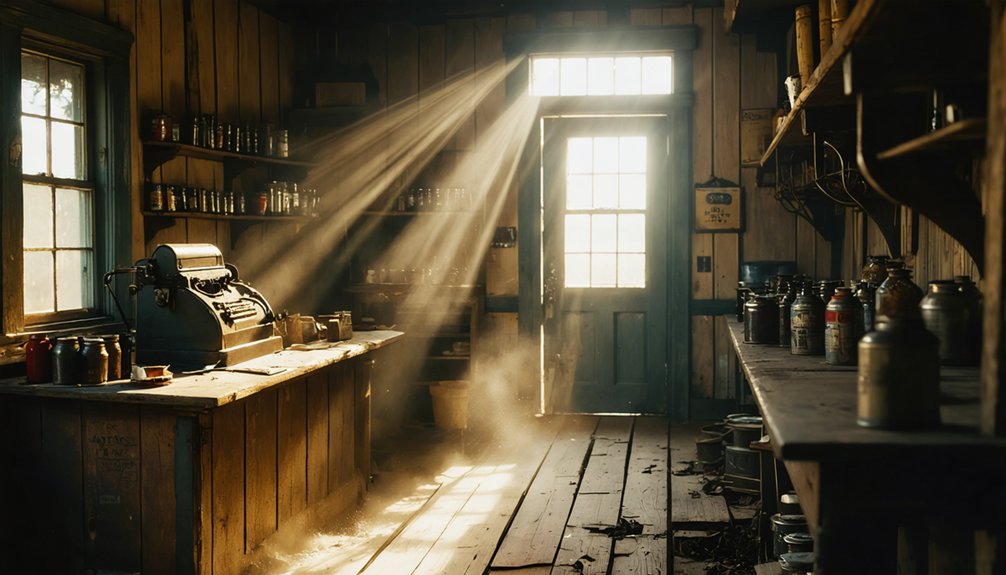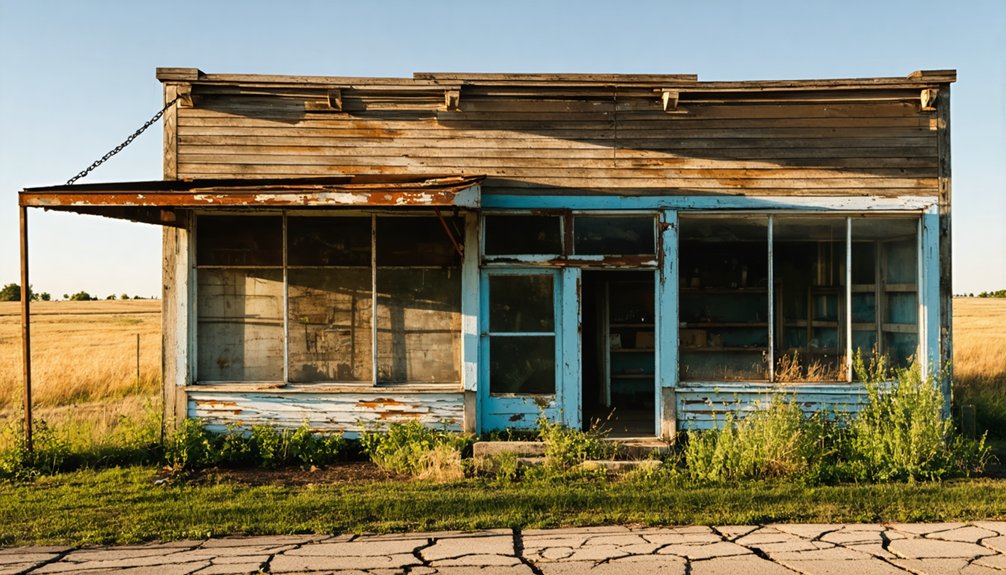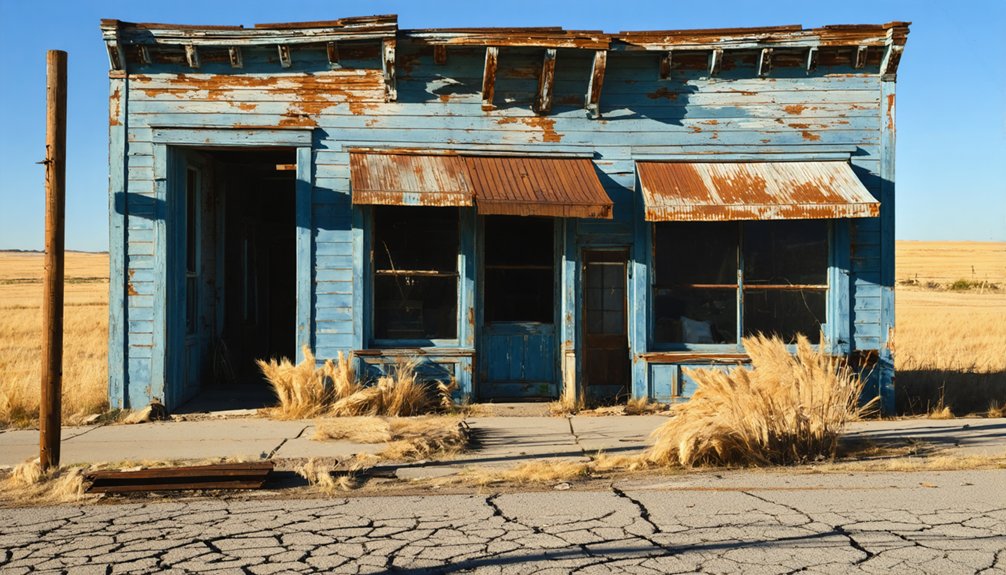You’ll find Pearl City marked on the 1893 Rand McNally map as a modest settlement in Beadle County, South Dakota, approximately 60 miles northwest of present-day Sioux Falls. This agricultural frontier town emerged near Pearl Creek Township and the James River valley during the late 19th century’s western expansion. While no structures remain today, Pearl City’s brief existence near the fertile plains reveals fascinating insights about boom-and-bust cycles in American frontier settlements.
Key Takeaways
- Pearl City was a late 19th-century settlement in Beadle County, South Dakota, appearing on the 1893 Rand McNally map.
- Located near Pearl Creek Township and the James River valley, approximately 60 miles northwest of present-day Sioux Falls.
- The town relied primarily on agriculture but struggled due to lack of railroad access and limited business diversification.
- No structures remain today, suggesting systematic dismantling after the town’s abandonment.
- The site exemplifies the boom-and-bust cycle common to frontier settlements, with nature now having reclaimed the area.
Origins and Naming
While many South Dakota ghost towns boast rich histories tied to mining or railroads, Pearl City emerged as a modest settlement in Beadle County during the late 19th century.
Like the more than six hundred ghost towns scattered across the Black Hills region, Pearl City’s exact historical records are limited. Similar to Rockerville, it offers visitors haunting experiences through its abandoned buildings and quiet streets. You’ll find it marked on the 1893 Rand McNally and Company map, though settler motivations for establishing the town remain largely mysterious. Like many prairie communities of its era, Pearl City likely sprouted from agricultural ambitions and homesteading dreams.
The naming significance of Pearl City has been lost to time.
Whether it referenced a pearl of the prairie, a local water feature, or simply reflected settlers’ hopes for prosperity, you won’t find definitive documentation. What you can be certain of is that Pearl was the settlement’s only known name, appearing briefly in historical records before fading into obscurity.
Location in Beadle County
You’ll find Pearl City‘s remnants in the rural plains of eastern Beadle County, South Dakota, where Pearl Creek Township meets the gently rolling agricultural terrain.
Historic maps from 1893 place the settlement near what’s now the James River valley, approximately 60 miles northwest of present-day Sioux Falls.
The ghost town‘s location typifies many of South Dakota’s abandoned prairie settlements, situated in an area that later became known for its rich farmland and Hutterite colonies. The area’s first permanent settler, Charles Miner, established his homestead near Pearl Creek in April 1879.
Positioned at an elevation of 396 meters, the abandoned township offers visitors panoramic views of the surrounding countryside.
Geographic Setting and Terrain
The ghost town of Pearl City lies within the fertile plains of east-central South Dakota’s Beadle County, centered near the convergence of Pearl Creek and the James River.
You’ll find this vanished settlement amid vast, unbroken terrain that’s typical of the Great Plains region, where geographical features include gently rolling hills giving way to expansive farmland stretching to the horizon.
The terrain characteristics of Pearl City’s former location showcase rich, fertile soil that’s ideal for growing wheat, corn, and soybeans.
While the landscape is mainly treeless, you’ll notice scattered stands of trees along Pearl Creek and the James River’s riparian zones.
The area’s relatively low elevation and flat topography made it particularly appealing to early settlers seeking productive agricultural land with reliable water access.
The region spans approximately 1,265 square miles of predominantly agricultural land.
Today, the area is home to the Pearl Creek Colony, a Hutterite community that continues the agricultural tradition of the region.
Historical Map References 1893
According to historical maps from 1893, Pearl City appeared prominently on Rand McNally and Company’s detailed cartographic records of Beadle County, South Dakota.
Through historical cartography and map analysis, you’ll find the ghost town clearly marked alongside Pearl Creek Township and neighboring Sanborn County. Today, researchers can access 52 topographic maps of Beadle County to study the area’s historical development.
You can access high-resolution scans of these 1893 maps through the U.S. Geological Survey and Library of Congress archives, where they’re available for detailed study. Users can utilize the Find My Location feature to compare historical locations with present-day coordinates.
When you overlay these historical documents with modern satellite imagery, you’ll notice how Pearl City’s location aligns with period transportation routes and township boundaries.
The maps’ detailed legends and symbols help distinguish Pearl City’s status among other settlements, while cadastral surveys from the era reveal property parcels and street layouts of this vanished community.
Rural Plains Settlement Area
Located in Beadle County, South Dakota, Pearl City emerged as a small settlement within the expansive Rural Plains region, where flat, open landscapes and deep loamy soils drew hopeful homesteaders during the late 19th century.
You’ll find it positioned between the James River to the west and the Minnesota River valley to the east, in what was once a bustling corridor for trade and transportation across the Missouri Plateau.
The settlement patterns followed typical homesteader logic: families clustered near essential water sources and potential transport routes, much like the early mining communities that established schoolhouses and saloons to serve their growing populations.
Agricultural practices focused on wheat, corn, and oats, with farmers taking advantage of the rich, loamy soil.
While Pearl City’s exact location supported farming ventures, its failure to secure a railroad connection likely contributed to its eventual decline and abandonment, similar to how better roads triggered the downfall of nearby Awanka.
Historical Significance
Established during the late 19th century’s western expansion, Pearl City emerged as a notable settlement in Beadle County, South Dakota, earning recognition on prominent maps like the 1893 Rand McNally publication.
The town’s cultural heritage reflects the dynamic spirit of frontier development, as settlers sought opportunities in mining and railroad ventures across the Black Hills region.
You’ll find Pearl City’s story mirrors the economic shifts that shaped South Dakota’s development. Like many towns of its era, it likely thrived on resource extraction or railroad commerce before facing decline.
While no major structures remain today, the town’s historical footprint provides valuable insights into the region’s boom-and-bust cycles. Pearl City stands as a monument to the ambitious settlement patterns that transformed the American frontier during the late 1800s.
Life in Pearl City

While you’d find most Pearl City residents primarily engaged in mining work, many supplemented their income through small vegetable gardens and modest livestock operations to sustain their families.
You’d commonly see residents gathering at the local establishments after work hours, likely including a saloon and general store that served as natural meeting points for the community.
The town’s social fabric was strengthened through these daily interactions, as neighbors relied on each other for survival in the harsh Black Hills environment.
Daily Farming Routines
As dawn broke over Pearl City’s fertile plains, farmers began their daily routines that hadn’t changed much since the town’s earliest days. You’d find yourself heading to the fields with simple tools in hand, knowing your livelihood depended on understanding the land’s rhythms.
Working alongside fellow townspeople, you’d implement crop rotation to keep the soil rich, shifting between maize, beans, and squash throughout the growing seasons.
Your harvesting techniques would follow time-tested methods, often relying on manual labor and basic machinery. You’d store your yield in the town’s wooden barns and graineries, essential structures that protected your hard work from the elements.
The Missouri River’s proximity made transporting surplus crops easier, though you’d still face the region’s unpredictable weather and economic pressures that challenged every Pearl City farmer.
Community Gathering Spots
During Pearl City’s heyday, the railroad depot served as the beating heart of community life, where you’d find townspeople congregating to welcome new arrivals, ship their grain, or simply exchange the latest news.
You’d discover a vibrant network of community interactions at the general store, where locals gathered to trade goods and share stories. The post office buzzed with activity as residents collected mail and caught up on regional happenings.
For social events and entertainment, you might’ve stopped by the saloon or attended celebrations in the town square.
While formal venues like churches and schools may have been modest, impromptu gatherings at private homes and outdoor activities kept the community spirit alive until Pearl City’s eventual decline.
Economic Development
Like many frontier settlements in South Dakota, Pearl City’s economic development centered primarily on agriculture and basic commerce in its early days.
You’d have found local farmers working small homestead plots while general stores and essential services formed the backbone of the town’s economic sustainability. Without railroad access or significant industrial diversification, Pearl City struggled to maintain long-term growth.
The town’s over-reliance on agriculture proved to be its Achilles’ heel.
While successful towns in the region achieved rural revitalization through varied industries and transportation links, Pearl City couldn’t attract new businesses or settlers to strengthen its economic base.
Natural disasters and market fluctuations likely dealt devastating blows to the farming-dependent community, ultimately contributing to its abandonment.
The lack of economic diversity that plagued many frontier towns sealed Pearl City’s fate.
Decline and Abandonment

Despite appearing on an 1893 Rand McNally map, Pearl City’s existence proved remarkably brief, leaving historians with more questions than answers about its decline.
Economic factors likely triggered the town’s downfall, as it lacked a diverse business foundation and relied heavily on a single, undocumented industry. The rapid population dynamics suggest a swift exodus, with residents abandoning their properties and leaving no physical trace of the settlement.
Lack of economic diversity and dependence on a single industry sealed Pearl City’s fate, triggering a rapid and complete abandonment.
- No standing structures or foundations remain, indicating systematic dismantling
- Complete absence from historical records after initial map appearance
- Zero surviving census data or population estimates
- No documented efforts to revitalize or repurpose the town
You won’t find the usual ghost town ruins here – Pearl City vanished so thoroughly that even its exact location remains uncertain.
The town’s story serves as a stark reminder of how quickly frontier settlements could rise and fall.
Legacy and Present Day
While Pearl City briefly flickered on South Dakota’s historical radar in 1893, its legacy today exists primarily in cartographic records and ghost town registries.
You’ll find no remaining structures or visible artifacts at the site – nature has reclaimed what was once a hopeful frontier settlement.
Pearl City’s story enriches South Dakota’s broader ghost town narratives, exemplifying the transient settlements that rose and fell with the region’s mining and railroad fortunes.
Unlike some preserved Black Hills ghost towns, Pearl City has vanished completely, leaving no physical traces for modern exploration or tourism.
Instead, it serves as a powerful reminder of the impermanence of single-industry towns in the American West.
The site’s total disappearance speaks to the volatile nature of 19th-century frontier development and its lasting impact on regional history.
Frequently Asked Questions
Were There Any Notable Crimes or Lawlessness Reported in Pearl City?
You won’t find documented crime incidents or law enforcement records from Pearl City. Unlike notorious towns like Deadwood, there’s no surviving evidence of major lawlessness in this small mining settlement.
What Natural Disasters or Extreme Weather Events Affected Pearl City?
Like a watery grave swallowing dreams, you’d have faced devastating flooding incidents during heavy rains and spring thaws. Deep ditches couldn’t always save your roads from becoming rivers amid severe storms.
Did Native American Tribes Have Any Significant Interactions With Pearl City?
You’ll find that Dakota and Lakota tribes maintained a deep connection to this region, with their tribal history predating Pearl City’s existence and cultural exchange continuing through sacred claims to the Black Hills territory.
What Was the Average Property Value or Cost of Living There?
Like scattered gold dust in time’s wind, you’ll find exact property prices remain elusive. While basic mining town costs were modest, there’s no surviving documentation for specific cost comparisons from Pearl City.
Were There Any Famous or Noteworthy Residents Who Lived in Pearl City?
You won’t find any famous residents or people of historical significance documented in Pearl City’s records. Despite appearing on 1893 maps, there’s no evidence of notable inhabitants in this frontier town.
References
- https://www.youtube.com/watch?v=Glucs_Rq8Xs
- https://www.sdpb.org/rural-life-and-history/2023-08-21/some-black-hills-ghost-towns-and-their-origins
- https://www.powderhouselodge.com/black-hills-attractions/fun-attractions/ghost-towns-of-western-south-dakota/
- https://www.youtube.com/watch?v=_0WNYsFLSLA
- https://www.sdhspress.com/journal/south-dakota-history-2-2/some-black-hills-ghost-towns-and-their-origins/vol-02-no-2-some-black-hills-ghost-towns-and-their-origins.pdf
- https://www.blackhillsbadlands.com/blog/post/old-west-legends-mines-ghost-towns-route-reimagined/
- https://en.wikipedia.org/wiki/List_of_ghost_towns_in_South_Dakota
- https://icatchshadows.com/okaton-and-cottonwood-a-photographic-visit-to-two-south-dakota-ghost-towns/
- https://www.tripadvisor.com/Attraction_Review-g54726-d622050-Reviews-South_Dakota_s_Original_1880_Town-Murdo_South_Dakota.html
- https://www.beadlesd.org/177/About-Us



